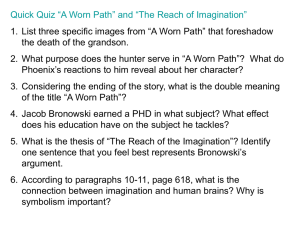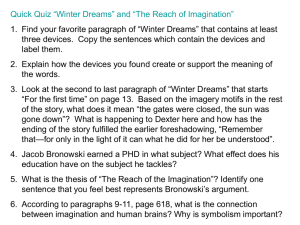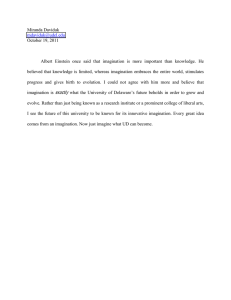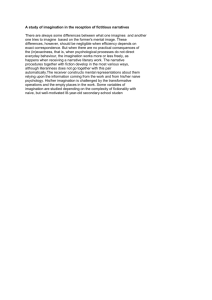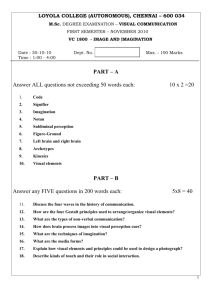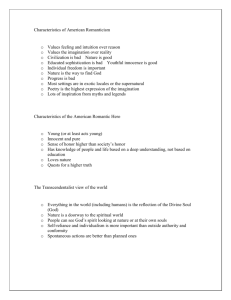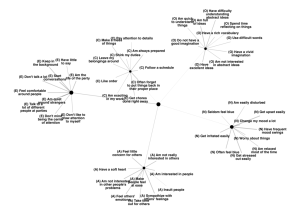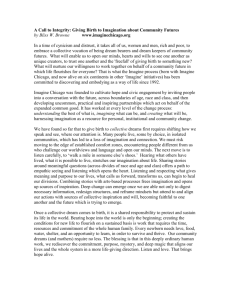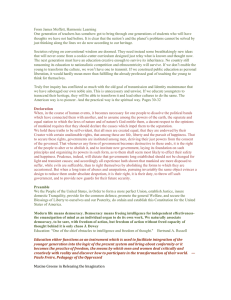J acob Bronowski
advertisement
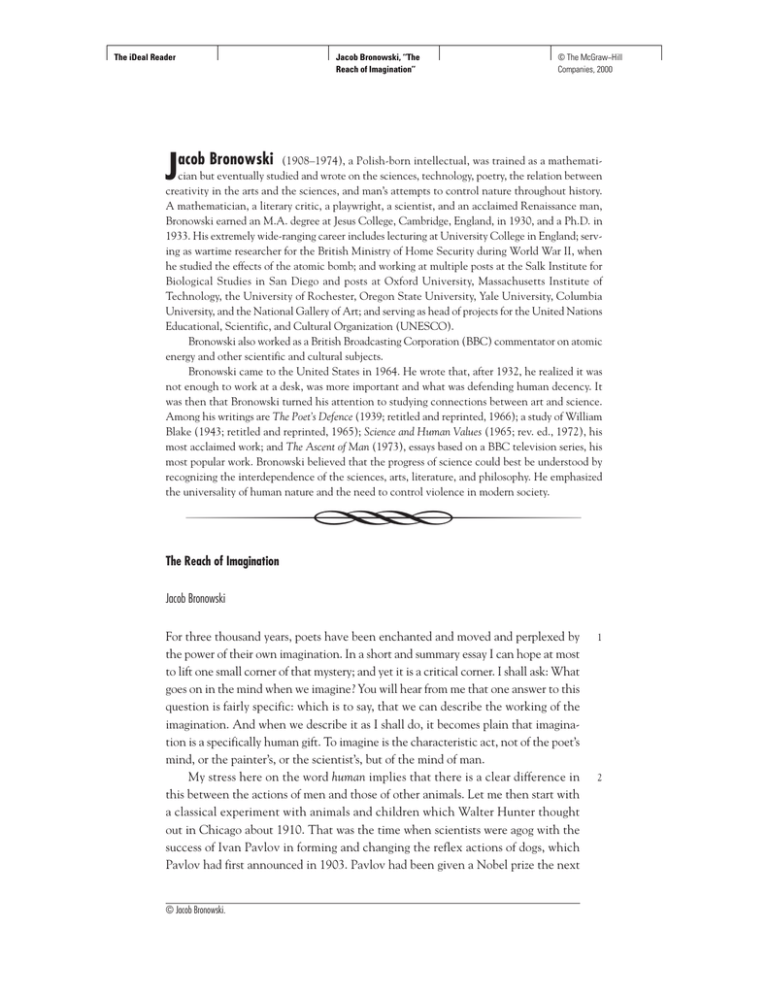
The iDeal Reader Jacob Bronowski, ‘‘The Reach of Imagination’’ © The McGraw−Hill Companies, 2000 Jacob Bronowski (1908–1974), a Polish-born intellectual, was trained as a mathematician but eventually studied and wrote on the sciences, technology, poetry, the relation between creativity in the arts and the sciences, and man’s attempts to control nature throughout history. A mathematician, a literary critic, a playwright, a scientist, and an acclaimed Renaissance man, Bronowski earned an M.A. degree at Jesus College, Cambridge, England, in 1930, and a Ph.D. in 1933. His extremely wide-ranging career includes lecturing at University College in England; serving as wartime researcher for the British Ministry of Home Security during World War II, when he studied the effects of the atomic bomb; and working at multiple posts at the Salk Institute for Biological Studies in San Diego and posts at Oxford University, Massachusetts Institute of Technology, the University of Rochester, Oregon State University, Yale University, Columbia University, and the National Gallery of Art; and serving as head of projects for the United Nations Educational, Scientific, and Cultural Organization (UNESCO). Bronowski also worked as a British Broadcasting Corporation (BBC) commentator on atomic energy and other scientific and cultural subjects. Bronowski came to the United States in 1964. He wrote that, after 1932, he realized it was not enough to work at a desk, was more important and what was defending human decency. It was then that Bronowski turned his attention to studying connections between art and science. Among his writings are The Poet’s Defence (1939; retitled and reprinted, 1966); a study of William Blake (1943; retitled and reprinted, 1965); Science and Human Values (1965; rev. ed., 1972), his most acclaimed work; and The Ascent of Man (1973), essays based on a BBC television series, his most popular work. Bronowski believed that the progress of science could best be understood by recognizing the interdependence of the sciences, arts, literature, and philosophy. He emphasized the universality of human nature and the need to control violence in modern society. R The Reach of Imagination Jacob Bronowski For three thousand years, poets have been enchanted and moved and perplexed by the power of their own imagination. In a short and summary essay I can hope at most to lift one small corner of that mystery; and yet it is a critical corner. I shall ask: What goes on in the mind when we imagine? You will hear from me that one answer to this question is fairly specific: which is to say, that we can describe the working of the imagination. And when we describe it as I shall do, it becomes plain that imagination is a specifically human gift. To imagine is the characteristic act, not of the poet’s mind, or the painter’s, or the scientist’s, but of the mind of man. My stress here on the word human implies that there is a clear difference in this between the actions of men and those of other animals. Let me then start with a classical experiment with animals and children which Walter Hunter thought out in Chicago about 1910. That was the time when scientists were agog with the success of Ivan Pavlov in forming and changing the reflex actions of dogs, which Pavlov had first announced in 1903. Pavlov had been given a Nobel prize the next © Jacob Bronowski. 1 2 The iDeal Reader Jacob Bronowski, ‘‘The Reach of Imagination’’ © The McGraw−Hill Companies, 2000 year, in 1904, although in fairness I should say that the award did not cite his work on the conditioned reflex, but on the digestive gland. Hunter duly trained some dogs and other animals on Pavlov’s lines. They were taught that when a light came on over one of three tunnels out of their cage, that tunnel would be open; they could escape down it, and were rewarded with food if they did. But once he had fixed that conditioned reflex, Hunter added to it a deeper idea: he gave the mechanical experiment a new dimension, literally—the dimension of time. Now he no longer let the dog go to the lighted tunnel at once; instead, he put out the light, and then kept the dog waiting a little while before he let him go. In this way Hunter timed how long an animal can remember where he has last seen the signal light to his escape route. The results were and are staggering. A dog or a rat forgets which one of three tunnels has been lit up within a matter of seconds—in Hunter’s experiment, ten seconds at most. If you want such an animal to do much better than this, you must make the task much simpler: you must face him with only two tunnels to choose from. Even so, the best that Hunter could do was to have a dog remember for five minutes which one of two tunnels had been lit up. I am not quoting these times as if they were exact and universal: they surely are not. Hunter’s experiment, more than fifty years old now, had many faults of detail. For example, there were too few animals, they were oddly picked, and they did not all behave consistently. It may be unfair to test a dog for what he saw, when he commonly follows his nose rather than his eyes. It may be unfair to test any animal in the unnatural setting of a laboratory cage. And there are higher animals, such as chimpanzees and other primates, which certainly have longer memories than the animals that Hunter tried. Yet when all these provisos have been made (and met, by more modern experiments) the facts are still startling and characteristic. An animal cannot recall a signal from the past for even a short fraction of the time that a man can—for even a short fraction of the time that a child can. Hunter made comparable tests with sixyear-old children, and found, of course, that they were incomparably better than the best of his animals. There is a striking and basic difference between a man’s ability to imagine something that he saw or experienced, and an animal’s failure. Animals make up for this by other and extraordinary gifts. The salmon and the carrier pigeon can find their way home as we cannot: they have, as it were, a practical memory that man cannot match. But their actions always depend on some form of habit: on instinct or on learning, which reproduce by rote a train of known responses. They do not depend, as human memory does, on calling to mind the recollection of absent things. Where is it that the animal falls short? We get a clue to the answer, I think, when Hunter tells us how the animals in his experiment tried to fix their recollection. They most often pointed themselves at the light before it went out, as some gun dogs point rigidly at the game they scent—and get the name pointer from the posture. The animal makes ready to act by building the signal into its action. There is a primitive imagery in its stance, it seems to me; it is as if the animal were trying to fix the light on its mind by fixing it in its body. And indeed, how else can a dog mark and 3 4 5 6 7 8 The iDeal Reader Jacob Bronowski, ‘‘The Reach of Imagination’’ © The McGraw−Hill Companies, 2000 (as it were) name one of three tunnels, when he has no such words as left and right, and no such numbers as one, two, three? The directed gesture of attention and readiness is perhaps the only symbolic device that the dog commands to hold on to the past, and thereby to guide himeself into the future. I used the verb to imagine a moment ago, and now I have some ground for giving it a meaning. To imagine means to make images and to move them about inside one’s head in new arrangements. When you and I recall the past, we imagine it in this direct and homely sense. The tool that puts the human mind ahead of the animal is imagery. For us, memory does not demand the preoccupation that it demands in animals, and it lasts immensely longer, because we fix it in images or other substitute symbols. With the same symbolic vocabulary we spell out the future—not one but many futures, which we weigh one against another. I am using the word image in a wide meaning, which does not restrict it to the mind’s eye as a visual organ. An image in my usage is what Charles Peirce called a sign, without regard for its sensory quality. Peirce distinguished between different forms of signs, but there is no reason to make is distinction here, for the imagination works equally with them all, and that is why I call them all images. Indeed, the most important images for human beings are simply words, which are abstract symbols. Animals do not have words, in our sense: there is no specific center for language in the brain of any animal, as there is in the human being. In this respect at least we know that the human imagination depends on a configuration in the brain that has only evolved in the last one or two million years. In the same period, evolution has greatly enlarged the front lobes in the human brain, which govern the sense of the past and the future; and it is a fair guess that they are probably the seat of our other images. (Part of the evidence for this guess is that damage to the front lobes in primates reduces them to the state of Hunter’s animals.) If the guess turns out to be right, we shall know why man has come to look like a highbrow or an egghead: because otherwise there would not be room in his head for his imagination. The images play out for us events which are not present to our senses, and thereby guard the past and create the future—a future that does not yet exist, and may never come to exist in that form. By contrast, the lack of symbolic ideas, or their rudimentary poverty, cuts off an animal from the past and the future alike, and imprisons him in the present. Of all the distinctions between man and animal, the characteristic gift which makes us human is the power to work with symbolic images: the gift of imagination. This is really a remarkable finding. When Philip Sidney in 1580 defended poets (and all unconventional thinkers) from the Puritan charge that they were liars, he said that a maker must imagine things that are not. Halfway between Sidney and us, William Blake said, “What is now proved was once only imagined.” About the same time, in 1796, Samuel Taylor Coleridge for the first time distinguished between the passive fancy and the active imagination, “the living Power and prime Agent of all human Perception.” Now we see that they were right, and precisely right: the human gift is the gift of imagination—and that is not just a literary phrase. 9 10 11 12 13 The iDeal Reader Jacob Bronowski, ‘‘The Reach of Imagination’’ © The McGraw−Hill Companies, 2000 Nor is it just a literary gift: it is, I repeat, characteristically human. Almost everything that we do that is worth doing is done in the first place in the mind’s eye. The richness of human life is that we have many lives, we live the events that do not happen (and some that cannot) as vividly as those that do, and if thereby we die a thousand deaths, that is the price we pay for living a thousand lives. (A cat, of course, has only nine.) Literature is alive to us because we live its images, but so is any play of the mind—so is chess: the lines of play that we foresee and try in our heads and dismiss are as much as part of the game as the moves that we make. John Keats said that the unheard melodies are sweeter, and all chess players sadly recall that the combinations that they planned and which never came to be played were the best. I make this point to remind you, insistently, that imagination is the manipulation of images in one’s head; and that the rational manipulation belongs to that, as well as the literary and artistic manipulation. When a child begins to play games with things that stand for other things, with chairs or chessmen, he enters the gateway to reason and imagination together. For the human reason discovers new relations between things not by deduction, but by that unpredictable blend of speculation and insight that scientists call induction, which—like other forms of imagination—cannot be formalized. We see it at work when Walter Hunter inquires into a child’s memory, as much as when Blake and Coleridge do. Only a restless and original mind would have asked Hunter’s questions and could have conceived his experiments, in a science that was dominated by Pavlov’s reflex arcs and was heading toward the behaviorism of John Watson. Let me find a spectacular example for you from history. What is the most famous experiment that you had described to you as a child? I will hazard that it is the experiment that Galileo is said to have made in Sidney’s age, in Pisa about 1590, by dropping two unequal balls from the Leaning Tower. There, we say, is a man in the modern mold, a man after our own hearts: he insisted on questioning the authority of Aristotle and St. Thomas Aquinas, and seeing with his own eyes whether (as they said) the heavy ball would reach the ground before the light one. Seeing is believing. Yet seeing is also imagining. Galileo did challenge the authority of Aristotle, and he did look at his mechanics. But the eye that Galileo used was the mind’s eye. He did not drop balls from the Leaning Tower of Pisa—and if he had, he would have got a very doubtful answer. Instead, Galileo made an imaginary experiment in his head, which I will describe as he did years later in the book he wrote after the Holy Office silenced him: the Discorsi . . . intorno a due nuove scienze, which was smuggled out to be printed in the Netherlands in 1638. Suppose, said Galileo, that you drop two unequal balls from the tower at the same time. And suppose that Aristotle is right—suppose that the heavy ball falls faster, so that it steadily gains on the light ball, and hits the ground first. Very well. Now imagine the same experiment done again, with only one difference: this time the two unequal balls are joined by a string between them. The heavy ball will again move ahead, but now the light ball holds it back and acts as a drag or brake. So the light ball will be speeded up and the heavy ball will be slowed down: they must reach the ground together because they are tied together, but they cannot reach the ground 14 15 16 17 18 The iDeal Reader Jacob Bronowski, ‘‘The Reach of Imagination’’ © The McGraw−Hill Companies, 2000 as quickly as the heavy ball alone. Yet the string between them has turned the two balls into a single mass which is heavier than either ball—and surely (according to Aristotle) this mass should therefore move faster than either ball? Galileo’s imaginary experiment has uncovered a contradiction; he says trenchantly, “You see how, from your assumption that a heavier body falls more rapidly than a lighter one, I infer that a (still) heavier body falls more slowly.” There is only one way out of the contradiction: the heavy ball and the light ball must fall at the same rate, so that they go on falling at the same rate when they are tied together. This argument is not conclusive, for nature might be more subtle (when the two balls are joined) than Galileo has allowed. And yet it is something more important: it is suggestive, it is stimulating, it opens a new view—in a word, it is imaginative. It cannot be settled without an actual experiment, because nothing that we imagine can become knowledge until we have translated it into, and backed it by, real experience. The test of imagination is experience. But then, that is as true of literature and the arts as it is of science. In science, the imaginary experiment is tested by confronting it with physical experience; and in literature, the imaginative conception is tested by confronting it with human experience. The superficial speculation in science is dismissed because it is found to falsify nature; and the shallow work of art is discarded because it is found to be untrue to our own nature. So when Ella Wheeler Wilcox died in 1919, more people were reading her verses than Shakespeare’s; yet in a few years her work was dead. It had been buried by its poverty of emotion and its trivialness of thought: which is to say that it had been proved to be as false to the nature of man as, say, Jean Baptiste Lamarck and Trofim Lysenko were false to the nature of inheritance. The strength of the imagination, its enriching power and excitement, lies in its interplay with reality—physical and emotional. I doubt if there is much to choose here between science and the arts: the imagination is not much more free, and not much less free, in one than in the other. All great scientists have used their imagination freely, and let it ride them to outrageous conclusions without crying “Halt!” Albert Einstein fiddled with imaginary experiments from boyhood, and was wonderfully ignorant of the facts that they were supposed to bear on. When he wrote the first of his beautiful papers on the random movement of atoms, he did not know that the Brownian motion which it predicted could be seen in any laboratory. He was sixteen when he invented the paradox that he resolved ten years later, in 1905, in the theory of relativity, and it bulked much larger in his mind than the experiment of Albert Michelson and Edward Morley which had upset every other physicist since 1881. All his life Einstein loved to make up teasing puzzles like Galileo’s, about falling lifts and the detection of gravity; and they carry the nub of the problems of general relativity on which he was working. Indeed, it could not be otherwise. The power that man has over nature and himself, and that a dog lacks, lies in his command of imaginary experience. He alone has the symbols which fix the past and play with the future possible and impossible. In the Renaissance, the symbolism of memory was thought to be mystical, and devices that were invented as mnemonics (by Giordano Bruno, for example, and by Robert Fludd) were interpreted as magic signs. The symbol is the tool which gives man his power, and it is the same tool whether the symbols are images or words, mathematical 19 20 21 The iDeal Reader Jacob Bronowski, ‘‘The Reach of Imagination’’ © The McGraw−Hill Companies, 2000 signs or mesons. And the symbols have a reach and a roundness that goes beyond their literal and practical meaning. They are the rich concepts under which the mind gathers many particulars into one name, and many instances into one general induction. When a man says left and right, he is outdistancing the dog not only in looking for a light; he is setting in train all the shifts of meaning, the overtones and the ambiguities, between gauche and androit and dexterous, between sinister and the sense of right. When a man counts one, two, three, he is not only doing mathematics: he is on the path to be mysticism of numbers in Pythagoras and Vituvius and Kepler, to the Trinity and the signs of the Zodiac. I have described imagination as the ability to make images and to move them about inside one’s head in new arrangements. This is the faculty that is specifically human, and it is the common root from which science and literature both spring and grow and flourish together. For they do flourish (and languish) together; the great ages of science are the great ages of all the arts, because in them powerful minds have taken fire from one another, breathless and higgledy-piggledy, without asking too nicely whether they ought to tie their imagination to falling balls or a haunted island. Galileo and Shakespeare, who were born in the same year, grew into greatness in the same age; when Galileo was looking through his telescope at the moon, Shakespeare was writing The Tempest and all Europe was in ferment, from Johannes Kepler to Peter Paul Rubens, and from the first table of logarithms by John Napier to the Authorized Version of the Bible. Let me end with a last and spirited example of the common inspiration of literature and science, because it is as much alive today as it was three hundred years ago. What I have in mind is man’s ageless fantasy, to fly to the moon. I do not display this to you as a high scientific enterprise; on the contrary, I think we have more important discoveries to make here on earth than wait for us, beckoning, at the horned surface of the moon. Yet I cannot belittle the fascination which that ice-blue journey has had for the imagination of men, long before it drew us to our television screens to watch the tumbling astronauts. Plutarch and Lucian, Ariosto and Ben Jonson wrote about it, before the days of Jules Verne and H. C. Wells and science fiction. The seventeenth century was heady with new dreams and fables about voyages to the moon. Kepler wrote one full of deep scientific ideas, which (alas) simply got his mother accused of witchcraft. In England, Francis Godwin wrote a wild and splendid work, The Man in the Moone, and the astronomer John Wilkins wrote a wild and learned one, The Discovery of a New World. They did not draw a line between science and fancy; for example, they all tried to guess just where in the journey the earth’s gravity would stop. Only Kepler understood that gravity has no boundary, and put a law to it—which happened to be the wrong law. All this was a few years before Isaac Newton was born, and it was all in his head that day in 1666 when he sat in his mother’s garden, a young man of twentythree, and thought about the reach of gravity. This was how he came to conceive his brilliant image, that the moon is like a ball which has been thrown so hard that it falls exactly as fast as the horizon, all the way round the earth. The image will do for any satellite, and Newton modestly calculated how long therefore an astronaut would take to fall round the earth once. He made it ninety minutes, and we have 22 23 24 The iDeal Reader Jacob Bronowski, ‘‘The Reach of Imagination’’ © The McGraw−Hill Companies, 2000 all seen now that he was right; but Newton had no way to check that. Instead he went on to calculate how long in that case the distant moon would take to round the earth, if indeed it behaves like a thrown ball that falls in the earth’s gravity, and if gravity obeyed a law of inverse squares. He found that the answer would be twentyeight days. In that telling figure, the imagination that day chimed with nature, and made a harmony. We shall hear an echo of that harmony on the day when we land on the moon, because it will be not a technical but an imaginative triumph, that reaches back to the beginning of modern science and literature both. All great acts of imagination are like this, in the arts and in science, and convince us because they fill out reality with a deeper sense of rightness. We start with the simplest vocabulary of images, with left and right and one, two, three, and before we know how it happened the words and the numbers have conspired to make a match with nature: we catch in them the pattern of mind and matter as one. 25 Questions for Discussion 1. 2. 3. 4. 5. 6. 7. What is Bronowski’s answer to the question he asks in his opening paragraph: “What goes on in the mind when we imagine?” What can humans do that animals cannot? What can animals do that humans cannot? Why have humans and animals developed differently? How and why do animals use their bodies as an aid to memory? How does Bronowski define “imagine” (Paragraph 9)? How is “imagine” linked to “imagery” (Paragraph 8)? Do you agree with Bronowski’s assertion that “imagination is not much more free, and not much less free, in [science] than in the [arts]” (Paragraph 20)? What do you think of the use of literary examples to illustrate scientific concepts? Why does imagination bridge the gap between science and art? How do the specific cases described by Bronowski highlight his points? Questions for Reflection and Writing 1. 2. 3. 4. List the examples used by Bronowski to illustrate his essay. If you have another scientific essay at hand, compare the use of examples. How do examples liven up scientific writing? Create an imaginary experiment to test a natural law, or create a fanciful theory to account for a natural occurrence, such as nightfall, the movement of the planets, thunderstorms, blushing, electricity, or locomotion. Find other experiments that were done to test the memory, imagination, or emotion of animals. Report to your classmates on what you find. If you find several studies, it would be best to summarize the key points of the studies, then focus in detail on one study. By doing this, you can avoid overgeneralizing; the details of one study would probably be more interesting and provocative than an essay that only summarizes. As an alternative, research what studies have been done on artificial intelligence. Summarize and focus on one study, as above.
